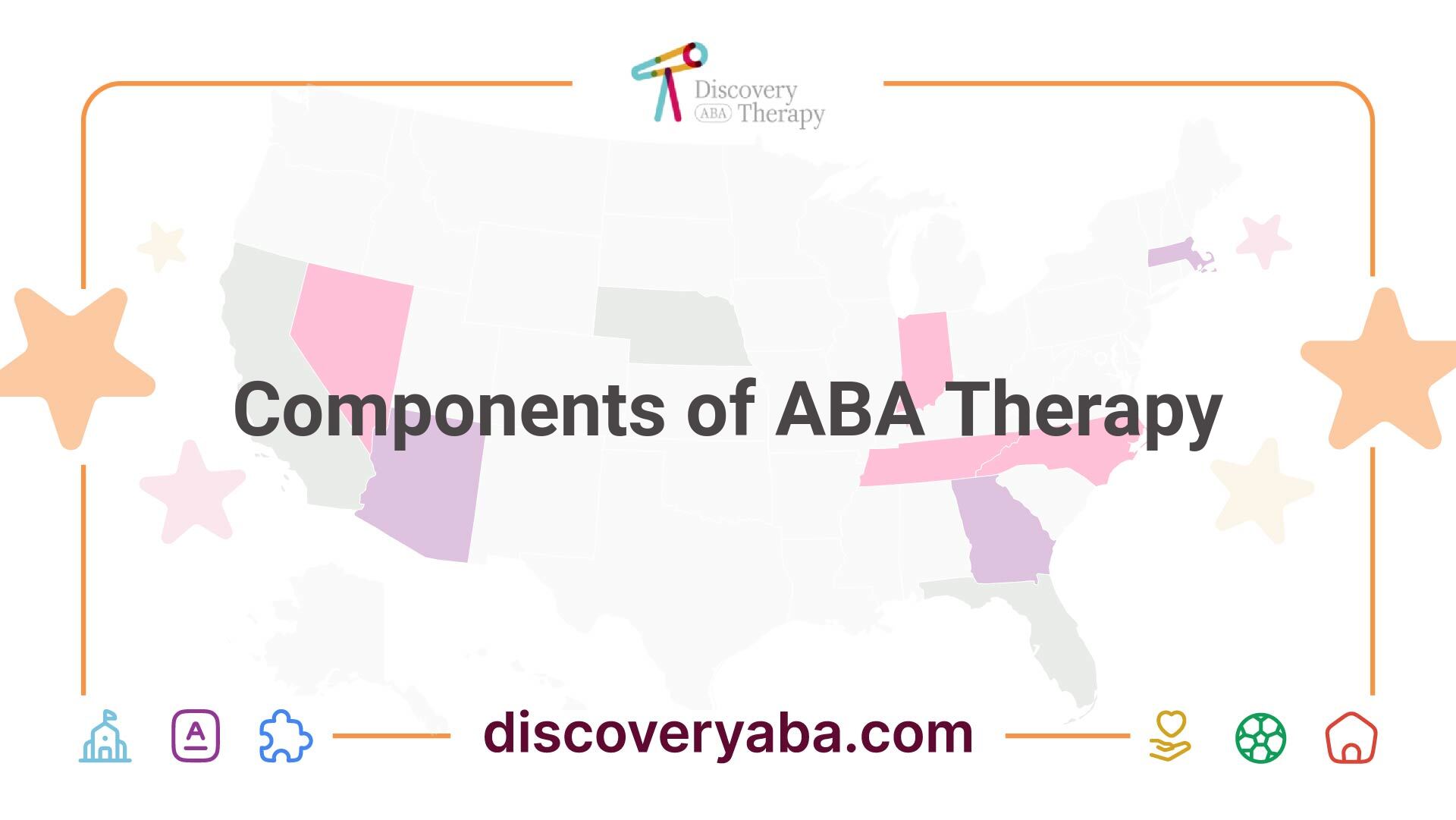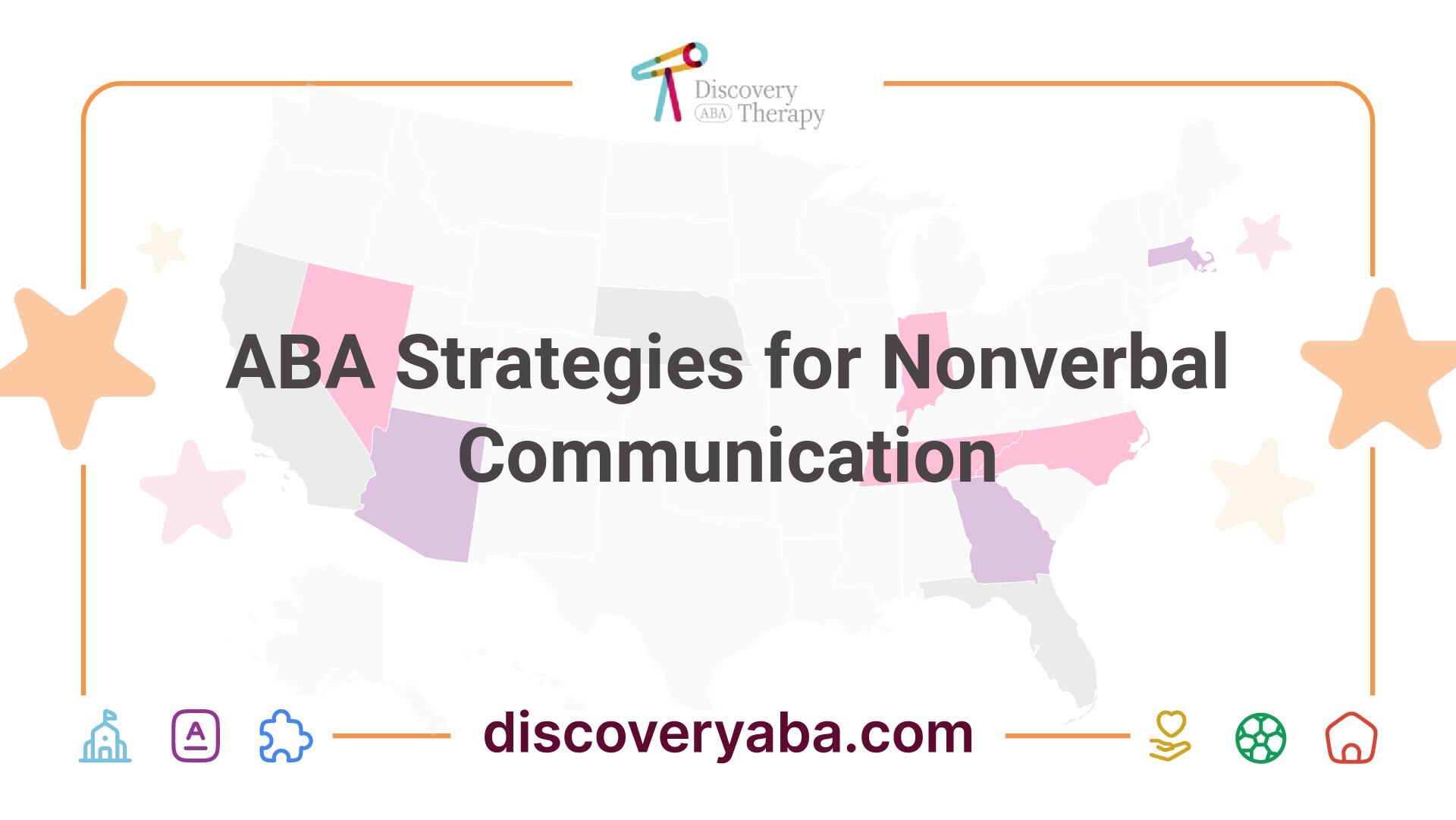ABA Strategies for Nonverbal Communication in Autism
Discover effective ABA for nonverbal communication in autism and unlock your child's potential with proven strategies.



Understanding ABA Therapy
ABA therapy, or Applied Behavior Analysis, is a scientific and evidence-based method designed to assist individuals with autism in learning and developing skills that enhance their behavior and communication. This approach is particularly effective as an early intervention strategy for children with autism, enabling them to acquire essential skills for daily living.
Basics of ABA Therapy
ABA therapy revolves around understanding behavior and applying strategies to promote positive outcomes. The therapy emphasizes skill acquisition and socialization, teaching individuals behaviors that are useful in various settings such as home, school, and public environments like grocery stores and parks (Behavioral Innovations). By using techniques like positive reinforcement, which may involve rewards such as praise or toys, ABA helps shape desirable behavior over time.
ABA focuses on seven key dimensions to ensure meaningful and effective treatment: Generalization, Effectiveness, Technological, Applied, Conceptually Systematic, Analytic, and Behavioral. This structured framework guarantees that individuals receiving therapy experience comprehensive support tailored to their developmental needs.
Importance of Early Intervention
Conducting ABA therapy at an early age has proven beneficial for children with autism. Research shows that more than 20 studies indicate that intensive and long-term application of ABA principles leads to significant improvements in various areas such as intellectual functioning, language development, daily living skills, and social abilities (Autism Speaks). Early intervention not only enhances the efficacy of treatment but also sets the foundation for ongoing development and adaptation in various life situations.
The effectiveness of early ABA therapy highlights the need for parents and caregivers to seek support promptly to help their children thrive. For further insights into how ABA can support various aspects of life, such as academic success, sleep challenges, and self-care skills, explore our articles on aba for academic success in autism, aba for sleep challenges in autism, and aba for self-care skills in autism.

Components of ABA Therapy
Applied Behavior Analysis (ABA) is a systematic approach tailored to improve specific behaviors in individuals, including those with autism. Understanding its components is crucial for parents and caregivers seeking effective strategies for enhancing nonverbal communication.
Behavioral Focus
The core of ABA lies in its behavioral focus, which emphasizes observable behaviors and the modifications that can be made through various interventions. ABA effectively employs various techniques to encourage desired behaviors while reducing those that may be maladaptive. It is anchored in the belief that behavior can be understood and modified much like any other skill.
Interventions based on behavioral principles have been substantiated by numerous studies over the decades, demonstrating their effectiveness in fostering significant skills and reducing problematic behaviors in individuals diagnosed with autism spectrum disorder (ASD) (NCBI). These techniques include shaping, discrete trial teaching, and pivotal response training, among others.
Seven Dimensions of ABA
ABA therapy is structured around seven key dimensions that ensure the treatment plans developed are effective and meaningful. These dimensions include:
DimensionDescriptionGeneralizationSkills learned should be transferrable to different contexts, situations, and settings.EffectivenessThe results of the intervention should produce significant and meaningful improvements in targeted behaviors.TechnologicalThe procedures used must be clearly described and replicable so that others can implement them as intended.AppliedThe focus is on behaviors that are important to the individual’s life and directly impact their daily functioning, such as improving communication.Conceptually SystematicInterventions should be based on established behavioral theories and principles, ensuring a robust conceptual framework.AnalyticThe effectiveness of the intervention should be measurable, demonstrating that the behavior change is due to the intervention.BehavioralEmphasis on the observable and measurable actions of the individual rather than subjective states (like feelings).
These dimensions guide the development of treatment plans that are personalized to meet the unique needs of individuals with autism. By employing the principles of ABA, parents and caregivers can find effective strategies to support nonverbal communication skills and other essential areas of development. For further insights on ABA channels that cater specifically to social communication, refer to our article on aba for social communication in autism.

ABA Strategies for Nonverbal Communication
Effective communication is crucial for individuals with Autism Spectrum Disorder (ASD). Utilizing Applied Behavior Analysis (ABA) techniques can help improve nonverbal communication skills. This section will focus on two prominent strategies: visual supports and prompting techniques.
Visual Supports
Visual supports are essential components of ABA strategies aimed at enhancing nonverbal communication in individuals with autism. These tools include methods such as picture cards, visual schedules, and charts that facilitate understanding and expression. By using visual aids, parents and caregivers can create clearer communication pathways, which can significantly benefit individuals struggling with verbal skills.
Type of Visual SupportDescriptionBenefitsPicture CardsImages representing objects, actions, or emotionsEnhances vocabulary and understandingVisual SchedulesDaily routines illustrated with imagesReduces anxiety by providing structureEmotion ChartsGraphics depicting various emotionsAids in identifying and expressing feelings
The adoption of visual supports has shown promising results in improving the interpretation and use of nonverbal cues among individuals with autism. When caregivers incorporate these supports into daily routines, they not only facilitate communication but also boost confidence and independence.
Prompting Techniques
Prompting techniques play a crucial role in encouraging individuals with autism to engage in nonverbal communication. These strategies involve guiding a person to respond in a desired manner through verbal, visual, or physical cues. The purpose of prompting is to assist individuals in taking the initiative to communicate effectively, ultimately fostering their social skills.
There are several types of prompts that caregivers can use:
Type of PromptDescriptionExampleVerbal PromptA spoken instruction or cue"Can you show me what you want?"Visual PromptA visual aid or reminderAn image of a drink when asking for waterPhysical PromptA gentle touch to guide actionsHand over hand assistance to point to an object
Combining these prompts with positive reinforcement can encourage individuals to initiate communication more frequently. As a result, they may develop better social skills and improve interactions with peers and caregivers (Innovate ABA).
Utilizing these techniques can be advantageous for enhancing nonverbal communication in individuals with autism. For more information on related topics, consider exploring aba for social communication in autism or teaching emotional expression with aba.

Enhancing Social Skills
ABA therapy plays a crucial role in fostering social skills and effective communication patterns in individuals with autism. Through tailored interventions, it provides the tools necessary for engaging more successfully in social interactions.
Role of ABA in Socialization
ABA techniques are designed to help individuals improve their social skills, including interaction with peers and understanding social cues. One key component is the emphasis on generalization, allowing children to transfer the skills learned during therapy to various real-world situations. This is essential for enhancing their success in daily life activities (Behavioral Innovations).
The following table outlines specific skills that can be developed through ABA for socialization:
Social SkillsDescriptionTurn-takingLearning to wait for one’s turn during conversations or gamesEye contactUnderstanding the importance of eye contact during interactionsRecognizing emotionsRecognizing and interpreting nonverbal cues such as facial expressionsBasic conversation skillsInitiating and maintaining a conversation effectively
By implementing individualized programs that focus on these skills, ABA therapy can significantly improve social interactions for those on the autism spectrum.
Developing Communication Patterns
Communication patterns are another critical focus area within ABA for nonverbal communication in autism. For individuals who may not use verbal speech, ABA uses techniques such as visual supports and prompting methods to encourage alternative forms of communication, including sign language or picture exchange systems (Innovate ABA).
The importance of clear and structured communication cannot be overstated, as it enhances the individual's ability to express their needs and preferences. The following table summarizes various communication strategies utilized in ABA:
Communication StrategyDescriptionVisual SupportsTools such as pictures, charts, and symbols that aid understandingPrompting TechniquesTechniques that guide individuals towards desired responses or actionsSocial StoriesNarratives that describe social situations to teach appropriate responsesRole-PlayingPracticing interactions in a safe and controlled environment
These strategies promote the development of effective communication, ultimately leading to improved social skills and relationships. The adaptability of ABA programs ensures that they meet the diverse needs of individuals, fostering greater independence. Through consistent application of these techniques, parents and caregivers can support the enhancement of social skills in individuals with autism, paving the way for successful interactions in their daily lives. For more information on improving social communication, visit our article on aba for social communication in autism.

ABA Techniques and Approaches
ABA (Applied Behavior Analysis) employs a variety of techniques to facilitate effective communication strategies, particularly for individuals with autism. This section will focus on two key approaches: Discrete Trial Training and Antecedent-based Interventions.
Discrete Trial Training
Discrete Trial Training (DTT) is a fundamental teaching method utilized in ABA therapy. DTT breaks skills down into small, manageable components, allowing for focused instruction on each element. Each trial consists of a clear instruction, the response from the individual, and immediate feedback. Positive reinforcement is provided for correct responses, which encourages the individual to repeat desired behaviors.
ComponentDescriptionInstructionA clear and concise prompt is given (e.g., "Point to the cat.")ResponseThe individual responds to the promptFeedbackImmediate reinforcement for correct responses
This structured approach not only aids in learning specific skills but also enhances nonverbal communication by allowing individuals to practice and receive feedback in a supportive environment.
Antecedent-based Interventions
Antecedent-based Interventions (ABI) focus on adjusting the environment to preemptively address potential challenges and reduce interfering behaviors. This method involves identifying triggers that lead to undesirable behavior and modifying those factors to promote more positive interactions and responses (Hidden Talents ABA).
StrategyDescriptionOffering ChoicesPresenting options to individuals to enhance their sense of control and reduce defianceEnvironmental ModificationsChanging aspects of the environment to decrease distractions or provocations
By creating a supportive environment that anticipates the needs of individuals, ABI can improve engagement and foster better communication, ultimately aiding in the development of nonverbal communication skills. For further insights on using ABA for different areas, such as academic success and social communication, explore our other resources.

Research and Criticisms
Evidence-based Practices
Applied Behavior Analysis (ABA) methods are recognized as evidence-based practices, demonstrating significant effectiveness for individuals diagnosed with Autism Spectrum Disorder (ASD). Endorsements from reputable organizations, such as Autism Speaks and The Association for Behavior Analysis International, support the efficacy of ABA-based interventions. The United States Surgeon General also advocates for these approaches as valuable tools in addressing nonverbal communication challenges in autism (NCBI).
Table 1 below illustrates key endorsements of ABA in autism treatment:
OrganizationSupport LevelAutism SpeaksStrong SupportAssociation for Behavior AnalysisStrong SupportUnited States Surgeon GeneralStrong Support
Addressing Concerns
Despite the widespread acceptance of ABA, concerns raised by autism rights and neurodiversity activists warrant attention. Some individuals criticize historical practices and current goals associated with ABA interventions. Common concerns include:
Further exploration of these concerns can help parents and caregivers make informed decisions regarding ABA for nonverbal communication in autism, as well as other related approaches such as teaching emotional expression with ABA and ABA for social communication in autism.
Find More Articles

How to Use ABA Therapy Techniques to Build Self-Care Skills

The Importance of Consistency in ABA Therapy Implementation

The Role of ABA Therapy in Teaching Self-Management Skills

How to Address Self-Stimulatory Behaviors in a Supportive Way

The Importance of Functional Communication Training in ABA Therapy

How Renewable Energy Supports Autism Communities

The Benefits of a Structured ABA Therapy Program

Creating Eco-Friendly Spaces for Autism

The Benefits of Parent-Implemented ABA Therapy Strategies

The Importance of Reinforcement Schedules in ABA Therapy

How to Support a Child with Autism in Group Learning Environments

The Connection Between ABA and Emotional Regulation

How ABA Therapy Helps Reduce Repetitive and Rigid Behaviors

Energy-Efficient Autism Community Resources

How to Use ABA Therapy to Reduce Excessive Repetitive Behaviors

The Role of Play in ABA Therapy

The Benefits of Combining ABA Therapy with Other Support Services

How ABA Therapy Helps Develop Self-Confidence in Children with Autism

The Role of Play-Based ABA Therapy in Early Childhood Development

The Role of Goal-Oriented Sessions in ABA Therapy

How ABA Therapy Works: A Step-by-Step Guide

The Role of Self-Management Strategies in ABA Therapy

How ABA Therapy Supports Emotional Expression in Children

The Role of Parent Training in ABA Programs

How ABA Therapy Supports Positive Transitions Between Activities

How to Reinforce ABA Learning in Community Settings

The Role of Functional Behavior Assessments in Preventing Problem Behaviors

How School-Based ABA Therapy Supports Classroom Success

How to Choose Between At-Home and Center-Based ABA Therapy

How ABA Therapy Helps Develop Conflict Resolution Skills

How to Identify the Best ABA Provider for Your Child

How to Use Token Economies in ABA Therapy

The Role of Peer Modeling in ABA Therapy Success

The Benefits of Naturalistic Teaching Approaches in ABA Therapy

What Is the ABCs of Behavior in ABA Therapy?

The Benefits of Group ABA Therapy for Social Skill Development

How to Encourage Positive Social Interactions with ABA Strategies

How to Introduce New Skills in ABA Therapy Without Overwhelming Your Child

The Benefits of Combining ABA Therapy with Other Interventions

Solar Power for Autism Support Networks

How to Address Hyperactivity with ABA Therapy

Common Misconceptions About ABA Therapy

Understanding the Principles of Positive Reinforcement

Understanding the Principles of Positive Reinforcement

Understanding the Principles of Positive Reinforcement

How ABA Therapy Supports Transitions Between Activities

Understanding the Principles of Positive Reinforcement

How to Identify and Celebrate Small Successes in ABA Therapy Progress

Understanding the Principles of Positive Reinforcement

How to Introduce Visual Schedules for Better Behavior Management

How ABA Therapy Can Reduce Self-Injurious Behaviors

How ABA Therapy Supports Academic Success

The Importance of Early Signs Recognition and ABA Intervention

How ABA Therapy Helps Improve Comprehension and Listening Skills

How to Use Visual Schedules to Support Your Child’s ABA Goals

How ABA Therapy Supports Self-Help Skills Like Dressing and Eating

How ABA Therapy Supports Behavioral Success in Community Settings

How ABA Therapy Helps Build Independence in Daily Activities

Building Social Skills Through ABA Therapy Techniques

The Role of School-Based Behavior Intervention Plans (BIPs)

The Benefits of Scripting and Role-Playing in ABA Therapy

How to Help Your Child Develop Coping Strategies with ABA Therapy

How to Address Hyperactivity and Attention Challenges with ABA Therapy

How to Help Your Child Develop Coping Strategies with ABA Therapy

How ABA Therapy Addresses Challenging Behaviors

The Importance of Social Skill Groups in ABA Therapy

How ABA Therapy Addresses Challenging Behaviors

The Role of Task Analysis in ABA Therapy for Teaching New Skills

How ABA Therapy Helps Improve Focus and Attention in the Classroom
%2520(1).jpeg)
Assessment Tools For People With Autism

Autism And Chronic Pain

How to Use Social Stories to Enhance ABA Therapy Outcomes

How ABA Therapy Helps Prepare Children for School Success

How School-Based ABA Therapy Can Improve Academic Performance

How to Address Resistance to ABA Therapy and Build Engagement

How to Use ABA Therapy to Develop Self-Help Skills in Daily Routines

How to Use Role-Playing in ABA Therapy for Skill Development

How to Handle Regression in Skills During ABA Therapy

How ABA Therapy Supports Social Communication Development

How to Find the Best ABA Therapy Provider for Your Child

How to Create a Reward System That Motivates Your Child in ABA Therapy

The Role of ABA Therapy in Preparing Children for Independent Living

How ABA Therapy Teaches Communication and Social Skills

How School-Based ABA Services Help Students with Autism Thrive

How ABA Therapy Helps Develop Patience and Waiting Skills

How to Support Your Child’s Social Interactions Using ABA Techniques

How ABA Therapy Addresses Anxiety and Fear Responses in Children

The Role of Play-Based ABA Therapy in Skill Development

How ABA Therapy Helps Build Confidence in Children with Autism

The Benefits of Center-Based ABA Therapy for School Readiness

The Role of ABA Therapy in Building Emotional Intelligence

How to Use Differential Reinforcement in ABA Therapy

Exploring Different ABA Techniques and Strategies

How to Prepare for IEP Meetings When Seeking ABA Therapy Support

How to Use ABA Therapy to Develop Resilience and Coping Mechanisms

How to Work with ABA Therapists to Set Realistic and Achievable Goals

How to Recognize Burnout in ABA Providers and Address It

The Connection Between ABA Therapy and Improved Social Skills
Contact us
North Carolina, Tennessee, Nevada, New Jersey, Utah, Virginia
New Hampshire, Maine
Massachusetts, Indiana, Arizona, Georgia
.avif)


